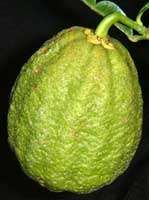Citrus ichangensis
| Citrus ichangensis | |
|---|---|
 | |
| Scientific classification | |
| Kingdom: | Plantae |
| (unranked): | Angiosperms |
| (unranked): | Eudicots |
| (unranked): | Rosids |
| Order: | Sapindales |
| Family: | Rutaceae |
| Genus: | Citrus |
| Species: | C. ichangensis |
| Binomial name | |
| Citrus ichangensis Swingle | |
Citrus ichangensis, the Ichang papeda (Chinese: 宜昌橙), is a slow-growing species of the Citrus subg. Papeda, which has characteristic lemon-scented foliage and flowers.
It is native to southwestern and west-central China[1] and is likely named for the city of Yichang (宜昌), in China's Hubei province. It is sometimes referred to as Citrus × ichangensis.
The Ichang papeda's main claim to fame is its unusual hardiness. With the exception of Poncirus trifoliata, it is the hardiest citrus plant, tolerating both moderate frost and damp conditions.[2] For this reason, it is perhaps the only species of true citrus which can be reliably grown outside in the temperate areas of Europe and the United States.
Description
Relatively rare in cultivation, the Ichang papeda is a large shrub or small tree, growing to 3-4.5 m,[3] and produces a small, mandarin-like fruit. Leaves feature a broad petiole, and resemble the leaves of the yuzu and the Kaffir lime in appearance. The fruit has a fragrant, but rugged rind, and may be oval, spherical, or flattened in shape, ripening to yellow or orange. The fruit contains many large monoembryonic seeds and a small quantity of bitter or sour juice; some fruits lack juice entirely and are instead filled with a mass of pith and seeds.
The Ichang papeda is occasionally grown as an ornamental.
Hybrids
- Ichang lemon (also known as the shangjuan)[2]
- Yuzu[2]
- Kabosu
- Hyuganatsu
Both the shangjuan and the yuzu have a number of culinary uses and are notably cold-hardy.
References
- ↑ Khan, Iqrar Ahmad (2007). Citrus genetics, breeding and biotechnology. CAB International. p. 27. ISBN 978-0-85199-019-4.
- 1 2 3 Spiegel-Roy, Pinchas; Goldschmidt, Eliezer E. (1996). Biology of citrus. Cambridge University Press. p. 32. ISBN 978-0-521-33321-4.
- ↑ Hogan, Sean (2008). Trees for all seasons: broadleaved evergreens for temperate climates. Timber Press. p. 79. ISBN 978-0-88192-674-3.